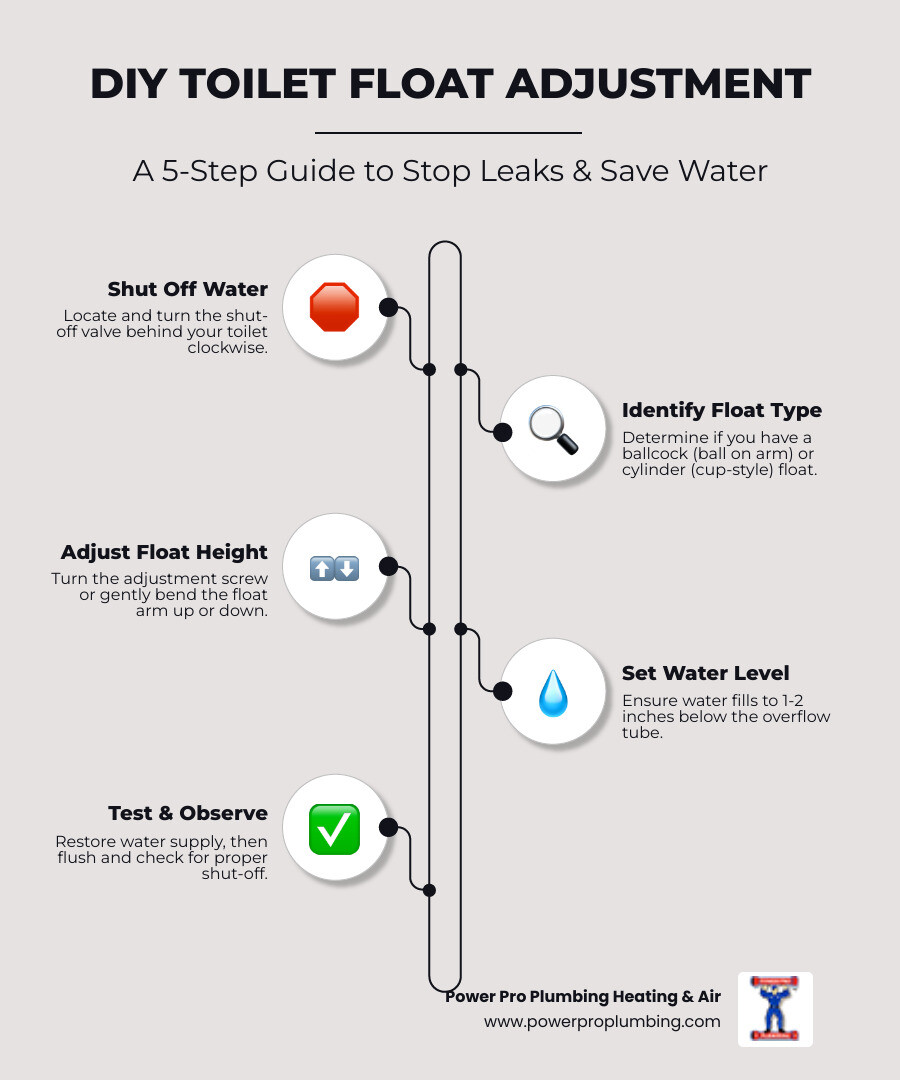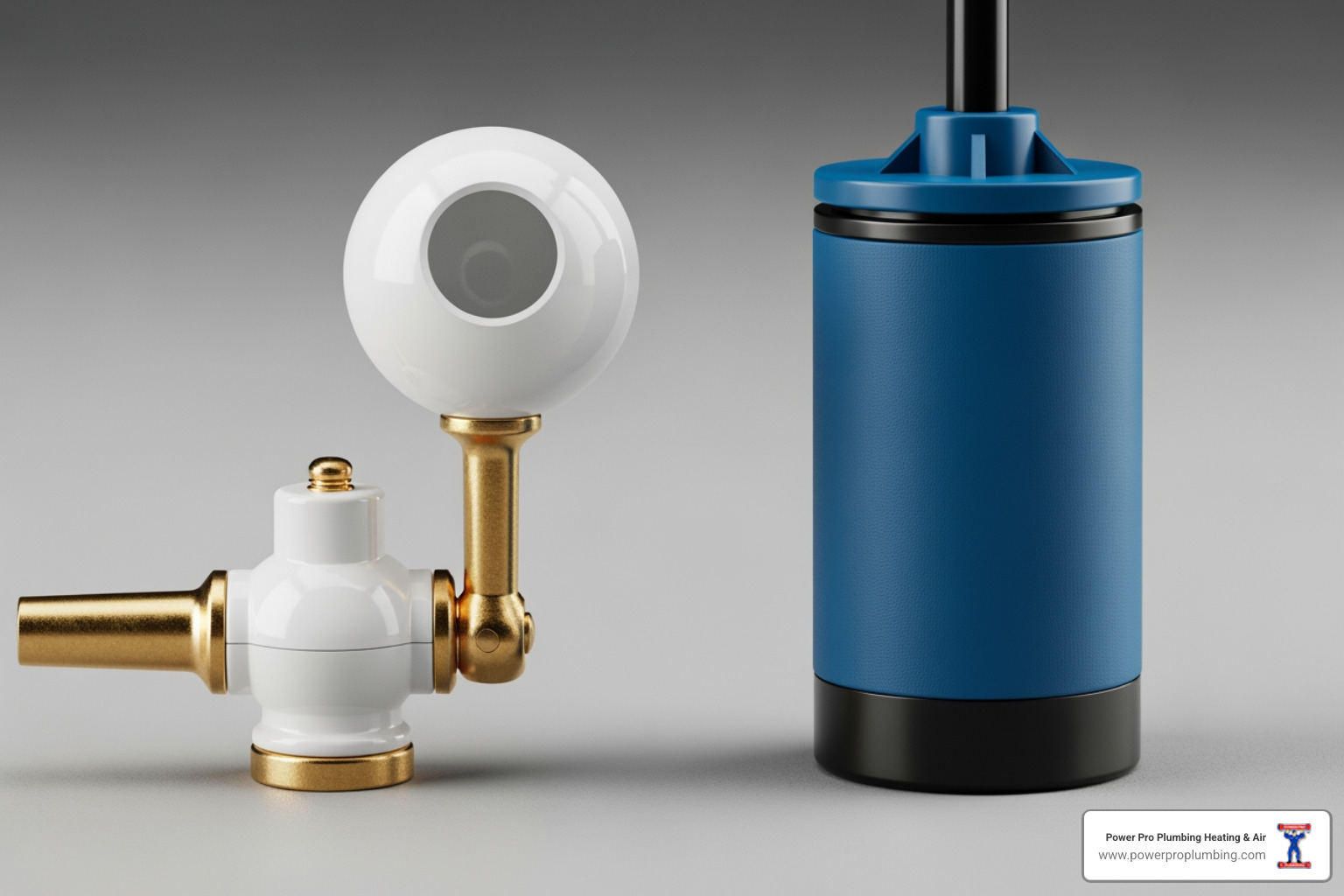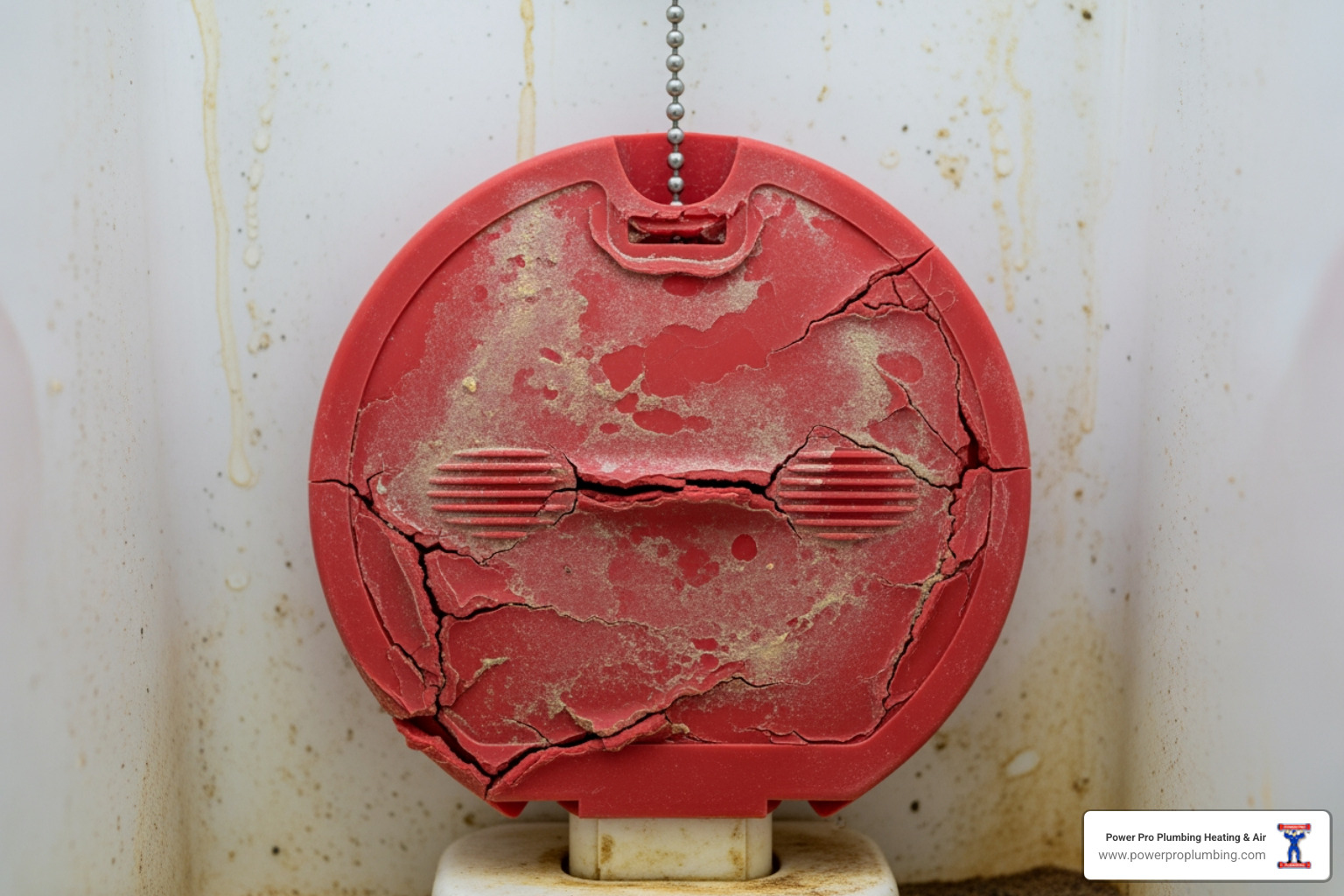
Why Your Toilet's Float Matters
Toilet float adjustment is a simple DIY fix that can stop a constantly running toilet, restore weak flushing power, and prevent water waste. Here's how to do it:
- Turn off the water supply to the toilet using the shut-off valve
- Identify your float type - ballcock (ball on arm) or cylinder (cup-style)
- Adjust the float height - turn the adjustment screw or bend the arm
- Set water level to 1-2 inches below the overflow tube
- Turn water back on and test the flush
If you hear trickling sounds, see water continuously running into your toilet bowl, or notice weak flushes that barely clear waste, your toilet float likely needs adjustment. The float controls when your toilet tank stops filling after each flush, and when it's set incorrectly, you're wasting water and money. A leaky toilet can waste up to 200 gallons of water a day—that's 73,000 gallons a year. The good news is that adjusting your toilet float takes just a few minutes and requires only basic tools most homeowners already have.
If you're dealing with more serious plumbing issues beyond float adjustment, our plumbing repair experts are here to help, or contact us for professional toilet services throughout Los Angeles.
I'm Daniel Rodriguez, a second-generation plumber with a C36 license who has performed countless toilet float adjustments during my years in the trade. Whether I'm training new technicians or handling repairs myself, toilet float adjustment remains one of the most common and easiest fixes that can save homeowners hundreds of dollars in wasted water.

The toilet float is a small but mighty component within your toilet tank that plays a crucial role in its efficiency and water conservation. Simply put, its job is to detect the water level in the tank and signal the fill valve to stop filling once the desired level is reached. Without a properly adjusted float, your toilet can waste significant amounts of water, leading to higher utility bills and frustrating issues like a toilet that runs constantly or one that doesn't flush effectively.
When the float is set too high, the tank overfills, and excess water drains into the overflow tube, wasting gallons with every flush. If the float is too low, there won't be enough water in the tank for a powerful flush, which can lead to clogs and an inefficient toilet. Correctly setting the float ensures optimal performance, conserves water, and saves you money.
Identifying Your Toilet's Float Type and Required Tools
Before you can adjust your toilet float, you need to know what kind of float mechanism you're working with. Not all toilets are built the same, and the type of float you have will determine exactly how you'll make your adjustments. The good news? Once you know what you're looking at, the process is straightforward.

Take a look inside your toilet tank and you'll likely see one of two main float types. The ballcock float is the classic design you might remember from older homes. It features a large round ball—usually plastic or brass—attached to a metal or plastic arm. As water fills the tank, the ball floats up, lifting the arm until it signals the fill valve to stop. It's simple, reliable, and has been around for decades.
The float cup (also called a cylinder float) is what you'll find in most modern toilets. Instead of a ball on an arm, this design uses a cup-shaped float that slides up and down along the fill valve shaft. As the tank fills, the cup rises and eventually triggers a lever that closes the fill valve. It's more compact and generally easier to adjust than the ballcock style.
Some newer toilets use an internal float valve where the float mechanism is built right into the fill valve body. You might not even see a traditional float—just a small adjustment screw or dial on top of the valve. These work on the same principle but keep everything contained in one unit.
Safety comes first. Before you start working inside your toilet tank, locate the water supply shut-off valve on the wall or floor behind your toilet. Turn it clockwise until it stops—this cuts off the water supply and prevents any messy surprises. Once the water is off, flush the toilet to drain the tank. This gives you a clear, dry workspace to see what you're doing.
A quick word about that toilet tank lid: it's heavier than it looks and often made of ceramic, which means it can crack or chip if you're not careful. Lift it straight up, set it somewhere safe, and keep it away from edges where it might fall.
Tools You'll Need:
- Screwdriver (Phillips or flathead) for turning adjustment screws
- Pliers or an adjustable wrench for loosening nuts if needed
- Sponge or soft cloth for soaking up leftover water and wiping away grime
Most toilet float adjustment jobs require nothing more than a screwdriver and maybe a pair of pliers. You probably have everything you need already sitting in a drawer somewhere. If you run into stubborn mineral deposits around the float or fill valve, that sponge will come in handy for a quick cleanup.
With your float type identified and your tools gathered, you're ready to make the actual adjustment and get that toilet working perfectly again.
Step-by-Step Toilet Float Adjustment for Different Mechanisms
The goal of any toilet float adjustment is to ensure the water in your tank reaches the ideal level after each flush. What is that ideal level, you ask?

The correct water level for a toilet tank is typically 1 to 2 inches below the top of the overflow tube. Many toilet tanks also have a manufacturer's mark or a water line indicator on the inside wall of the tank. This mark is your best guide for setting the perfect level. Ensuring the water level stays just below the overflow tube prevents water from continuously flowing into it, which is a common cause of running toilets and wasted water.
After making any adjustments, we always recommend testing the flush by flushing the toilet and observing the water level to ensure it's filling correctly and stopping at the appropriate height. You want to see a strong, efficient flush that clears the bowl without needing a second attempt.
How to Perform a Ballcock-Style Toilet Float Adjustment
Ballcock-style floats, with their distinctive ball and arm, are often found in older toilets in homes across the Los Angeles area. Adjusting them is straightforward, but the method depends on whether the arm is metal or plastic.
Start by turning off the water supply and emptying the tank. As always, shut off the water valve behind the toilet and flush to drain the tank. Remove the tank lid carefully and set it somewhere safe.
Next, locate the float and arm. You'll see the float ball—that hollow sphere attached to an arm extending from the fill valve. This is what rises and falls with the water level.
Now comes the actual adjustment. If you have a plastic arm with an adjustment screw, look for a small screw near the pivot point where the arm connects to the fill valve. To raise the water level (if your toilet has weak flushes or the water seems too low), turn the screw counterclockwise. This effectively shortens the arm's reach, allowing the float to rise higher before shutting off the water. To lower the water level (if water is trickling into the overflow tube), turn the screw clockwise. This lengthens the arm, causing the float to shut off the water sooner.
If you have a metal arm without an adjustment screw, you'll need to gently bend the float arm itself. To raise the water level, carefully bend the arm slightly upwards. To lower the water level, gently bend the arm slightly downwards. Be cautious here—you don't want to bend it too far or too forcefully, as this could damage the arm or the fill valve. Think small adjustments and retest rather than one big bend.
Once you've made your adjustment, turn the water supply back on and let the tank refill. Watch the new water level as it rises. Flush the toilet to ensure it flushes properly and the water stops filling at the desired height—about 1 inch below the overflow tube. If the level isn't quite right, repeat the adjustment process until it's perfect.
Properly adjusting your ballcock float can significantly improve your toilet's performance and water efficiency. If you're encountering persistent issues or considering a full toilet upgrade, our team at Power Pro Plumbing can help with plumbing repair services throughout the greater Los Angeles area.
How to Perform a Cylinder-Style Toilet Float Adjustment
Cylinder or float cup mechanisms are prevalent in newer toilets and are generally easier to adjust due to their design. The good news is that this type of toilet float adjustment is often quite precise, allowing you to fine-tune your water level for optimal flushing power and water conservation.
Begin by turning off the water supply and emptying the tank. Shut off the water valve behind the toilet, flush to drain the tank, and remove the tank lid.
Locate the float cup—that cylindrical piece that slides up and down a vertical shaft, usually part of the fill valve itself. It looks quite different from the old-fashioned ball-and-arm setup.
Most float cup mechanisms have an adjustment screw or a release clip (sometimes called a tab) on the vertical rod or at the top of the fill valve. This is your adjustment point.
To raise the water level (if your flushes are weak or the tank isn't filling enough), you'll move the float cup upward. If there's an adjustment screw, turn it counterclockwise. If there's a release clip, squeeze or pinch it and slide the float cup upwards along the shaft. Make small, incremental adjustments—many plumbers recommend one full rotation of a screw or a slight slide of the cup at a time.
To lower the water level (if water is running into the overflow tube or the tank is overfilling), you'll move the float cup downward. If there's an adjustment screw, turn it clockwise. If there's a release clip, squeeze it and slide the float cup downwards along the shaft.
After making your adjustment, turn the water supply back on and allow the tank to refill. Check the water level against the manufacturer's mark or ensure it's 1-2 inches below the overflow tube. Flush the toilet to confirm proper function and that the tank stops filling at the right point. If needed, make another small adjustment and test again.
If you find your float cup is damaged or the fill valve itself is faulty and adjustments aren't helping, it might be time for a replacement. Our expert plumbers can assist with toilet installation in Cerritos, CA and all surrounding communities in the Los Angeles area.
Troubleshooting When Adjustment Isn't Enough
Sometimes, even after careful toilet float adjustment, you might still experience issues. This could indicate a problem beyond simple float height, often involving other components within the toilet tank. Don't worry—you're not alone. Approximately 33% of homeowners report problems with their toilet fill valves, so if adjustments don't immediately solve the issue, there's likely another culprit at play.

Running Toilet (Still Running After Adjustment):
If your toilet continues to run or makes that constant trickling sound after adjusting the float, the float might be set too high, but more often than not, the real problem is a leaky flapper. The flapper is that rubber seal at the bottom of the tank that lifts when you flush and then drops down to hold water in the tank. Over time, flappers can harden, warp, or accumulate mineral deposits, preventing them from sealing properly.
To check if your flapper is the problem, try a simple dye test. Put a few drops of food coloring into the tank water and wait about 30 minutes without flushing. If colored water appears in the bowl, your flapper is leaking and needs replacement. Also, take a look at the chain connecting the flapper to the flush lever. If it's too long, it might get caught under the flapper, preventing a good seal. If it's too short, it won't let the flapper close completely.
Weak Flush or Phantom Flushes:
If adjusting the float to raise the water level doesn't improve a weak flush, there could be a few other issues at play. Your rim jets—those small holes under the rim of the toilet bowl—might be clogged with mineral deposits, reducing water flow during a flush. The flush valve assembly itself might also be faulty or misaligned.
Phantom flushes are those mysterious moments when your toilet randomly refills itself without anyone touching it. This is almost always caused by a slow leak from the tank into the bowl, typically from a faulty flapper that isn't sealing completely. Water slowly seeps out, triggering the fill valve to turn on and refill the tank.
Overflowing Tank:
If water continuously enters the overflow tube, the float is likely set too high, allowing the tank to overfill. However, if you've lowered the float and the issue persists, the fill valve itself might be faulty and not shutting off properly. Worn fill valve seals or internal damage can cause this problem, and in these cases, replacing the fill valve is often the best solution.
For more detailed guidance on these issues, check out our comprehensive guides on Troubleshooting Common Toilet Problems and 8 Most Common Plumbing Problems.
When to Call a Plumber:
While toilet float adjustment is a straightforward DIY task, there are times when it makes sense to call in the professionals. We recommend contacting a licensed plumber if your adjustments don't work after multiple attempts, if you notice cracks or persistent leaks from the fill valve, or if the float mechanism itself is broken or stuck. Internal tank damage like cracks or corrosion also warrants professional attention.
Sometimes, you might simply feel uncomfortable with the repair process—and that's perfectly okay. It's always better to have an expert handle it than risk causing further damage or water waste. If you're dealing with persistent leaks that you can't identify even after checking the flapper and fill valve, it's definitely time to bring in a pro.
For residents in the Los Angeles area, our Power Pro Plumbing team is always ready to provide expert toilet repair and replacement services. We've seen it all, and we're here to help you get your toilet working perfectly again without the hassle.
Frequently Asked Questions About Toilet Float Adjustment
Over my years in the plumbing business, I've heard just about every toilet question imaginable. And honestly? Most of them come back to that little float bobbing around in your tank. Let's tackle the most common questions we get at Power Pro Plumbing about toilet float adjustment and related issues.
How do I know if my toilet float is bad?
Great question—and one that can save you a lot of water and frustration if you catch it early. Your float might be failing if you're experiencing constant running where the toilet just won't stop filling, even though the tank looks full. This means the float isn't doing its job of telling the fill valve to shut off.
Another telltale sign is a weak flush that barely clears the bowl. When the float is set too low or isn't working properly, your tank doesn't fill with enough water to create the flushing power you need. For older ballcock-style floats with the ball and arm, try this simple test: carefully remove the float ball and give it a gentle shake. If you hear water sloshing inside the float ball, that's a problem—the ball has developed a leak, lost its buoyancy, and needs replacement.
Look for visible cracks or damage on the float itself, whether it's a ball or a cylinder cup. Even small cracks can affect how it operates. Sometimes the issue is mechanical—the float is stuck and can't move freely up and down with the water level. This can happen due to mineral buildup, corrosion, or simple wear and tear over time.
How do I increase the flushing power of my toilet?
If your toilet's flush feels more like a gentle suggestion than a powerful whoosh, the solution is usually straightforward: you need more water in the tank. The key is performing a toilet float adjustment to raise the water level so there's enough volume for an effective flush.
To adjust the float upwards, follow the instructions for your specific float type that we covered earlier in this guide. For a ballcock float, that means turning the adjustment screw counterclockwise or gently bending the metal arm upward. For a cylinder float, you'll either turn the adjustment screw counterclockwise or release the clip and slide the float cup higher on the shaft.
Here's the critical part: do not exceed the overflow tube height. Your water level should sit about 1 inch below the top of that overflow tube. Going higher won't give you a better flush—it'll just waste water by sending it straight down the overflow tube. That's like pouring money directly into the drain, and nobody wants that.
Why does my toilet keep running after I adjusted the float?
This is probably the most frustrating scenario, and I completely understand why. You've taken the time to adjust your float, everything looks good, and yet you still hear that annoying trickle of running water. Don't worry—there are a few common culprits.
First, double-check that the float isn't set too high. Sometimes we overcorrect, and the water level ends up above where it should be, causing water to flow continuously into the overflow tube. Try lowering it just a bit more.
The most common reason for a running toilet after float adjustment is actually a leaky flapper. That rubber seal at the bottom of your tank can wear out, become stiff, or develop mineral buildup that prevents it from sealing properly. When water slowly leaks past the flapper into the bowl, the tank water level drops, triggering the fill valve to turn on and refill—creating that constant running sound. It's sneaky because the leak might be so slow you don't see it happening.
Another possibility is a worn fill valve seal. Even with the float properly adjusted, if the internal seals in the fill valve are deteriorated, water can continue to flow. In this case, the entire fill valve assembly typically needs replacement rather than just adjustment.
Finally, check the refill tube position—that's the small tube that directs water back into the toilet bowl after a flush. It should be clipped onto the overflow tube and positioned so water flows into it, not outside of it. If it's inserted too far down into the overflow tube, it can create a siphoning effect that pulls water out of the tank.
If you've checked all these possibilities and your toilet is still running, it's time to bring in a professional. Our team at Power Pro Plumbing has diagnosed and fixed thousands of running toilets throughout Los Angeles, and we're always happy to help when DIY efforts aren't quite cutting it.
Conclusion: Maintain a Perfect Flush and Save Water
You've just learned a skill that can save you hundreds of dollars a year and make your bathroom work better every single day. Toilet float adjustment isn't just about fixing annoying sounds or stopping that constant trickle—it's about taking control of your home's water efficiency and performance.
Think about it: a properly adjusted float means no more wasted water flowing endlessly into the overflow tube, lower utility bills arriving in your mailbox, and better flushing performance every time you need it. It's a small adjustment that delivers big results, and you can do it yourself in just a few minutes with tools you probably already have.
The beauty of this repair is its simplicity. Whether you've got an older ballcock-style float or a modern cylinder mechanism, the principles remain the same: set the water level about an inch below the overflow tube, test your work, and enjoy a perfectly functioning toilet. It's the kind of DIY home repair that makes you feel accomplished—and saves you from calling a plumber for something you can handle on your own.
Of course, maintaining your home's plumbing goes beyond just the toilet float. Regular attention to your entire plumbing system can prevent problems before they start. For more practical advice on keeping everything running smoothly, take a look at our 10 Tips for Home Plumbing Success.
But here's the thing—we also know that sometimes a problem goes deeper than a simple adjustment. Maybe your flapper is worn out, your fill valve needs replacing, or you're dealing with persistent leaks that just won't quit no matter what you try. That's when it's time to bring in the professionals.
At Power Pro Plumbing Heating & Air, we've seen it all in our years serving the greater Los Angeles area. From simple float adjustments to complete toilet replacements, our licensed plumbers bring the expertise and experience to get your bathroom back in perfect working order. We're not just here to fix problems—we're here to give you peace of mind.
For persistent issues or professional help, trust the experts at Power Pro Plumbing. Contact us for expert toilet services in Los Angeles today, and let us take care of whatever's troubling your toilet. Your perfect flush is just a phone call away.

